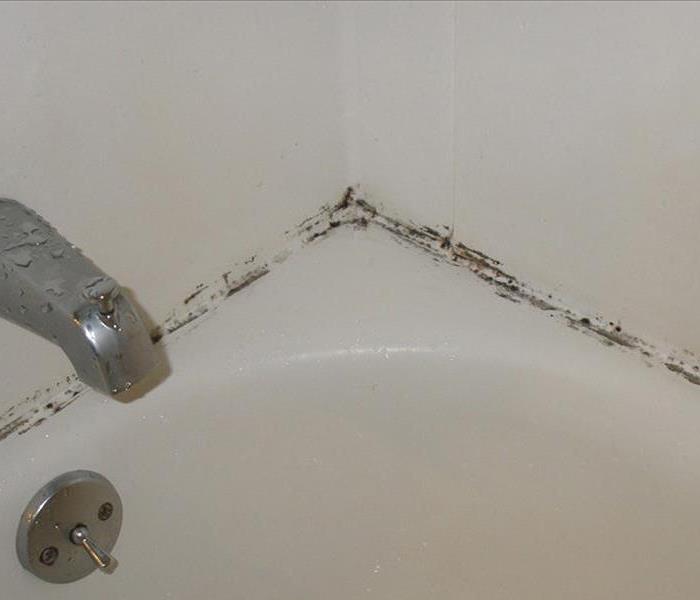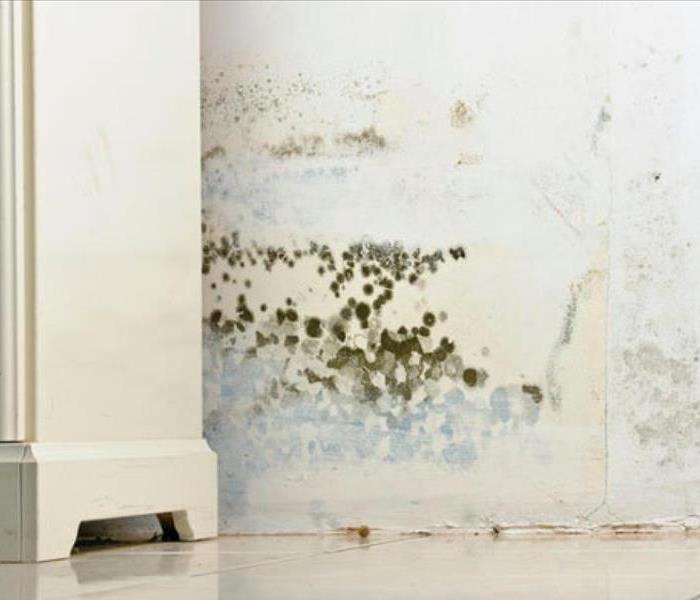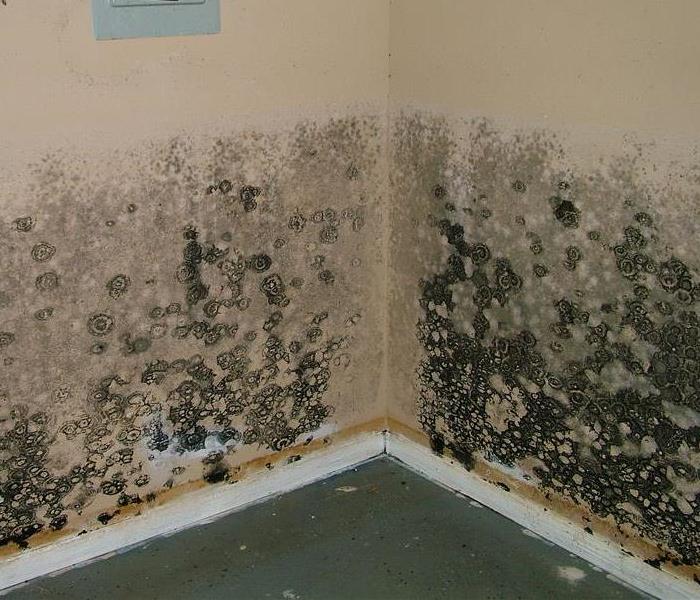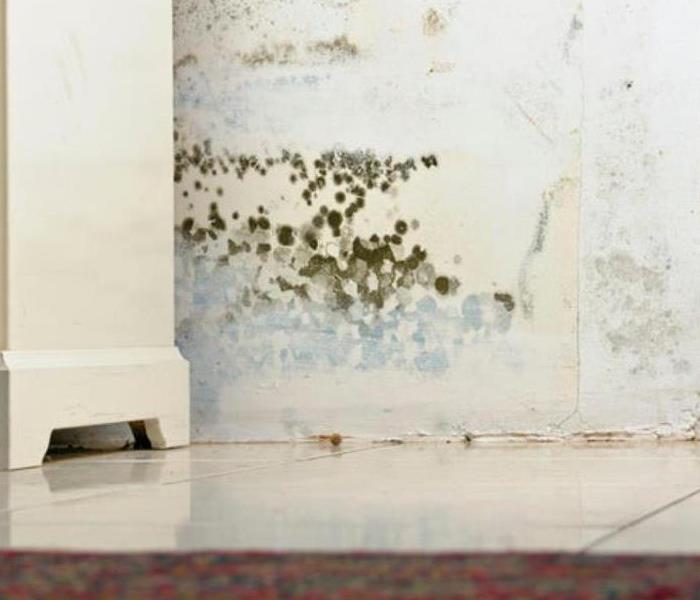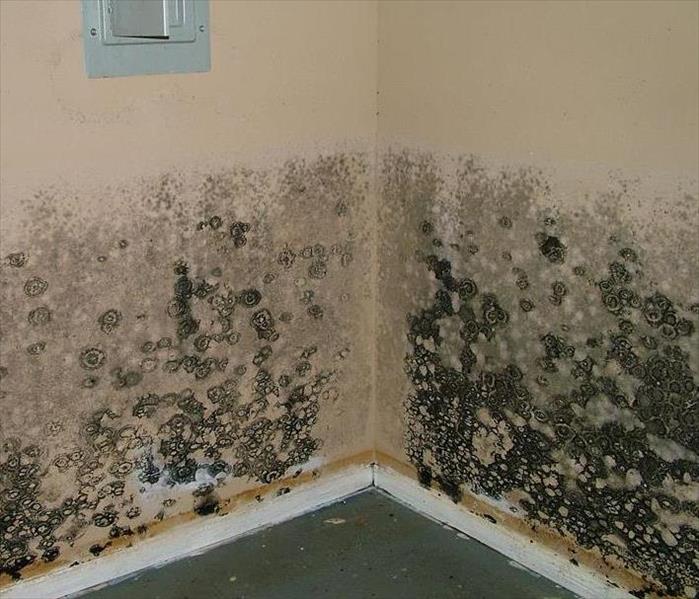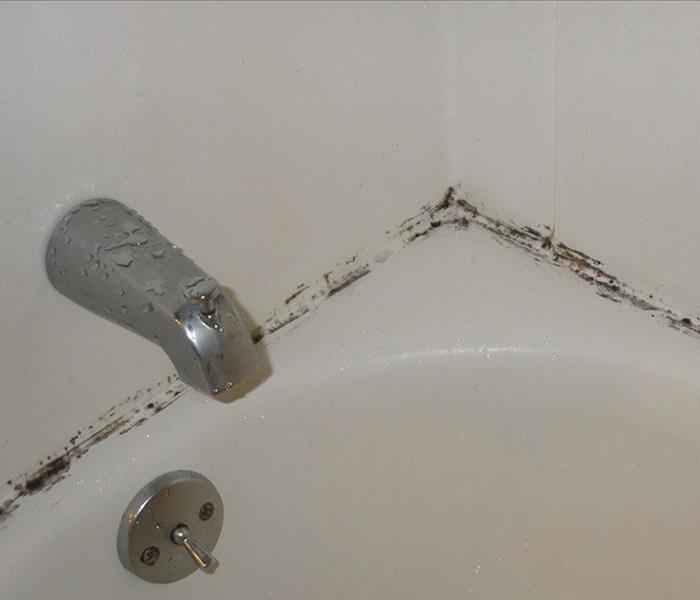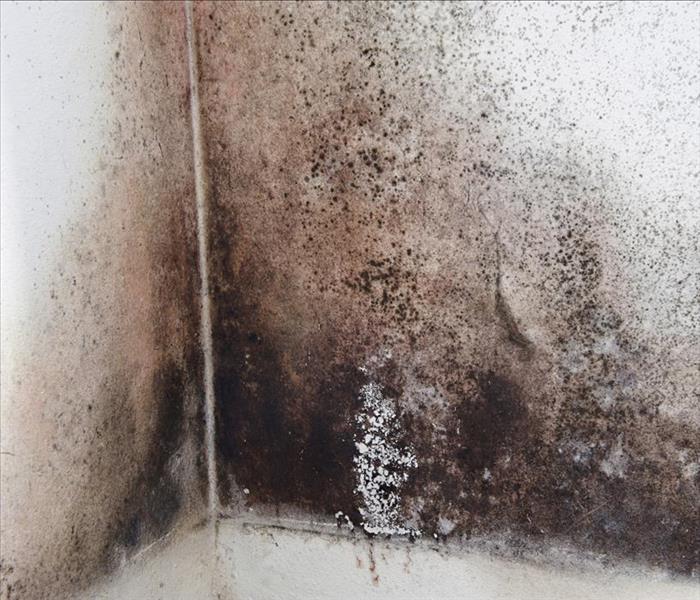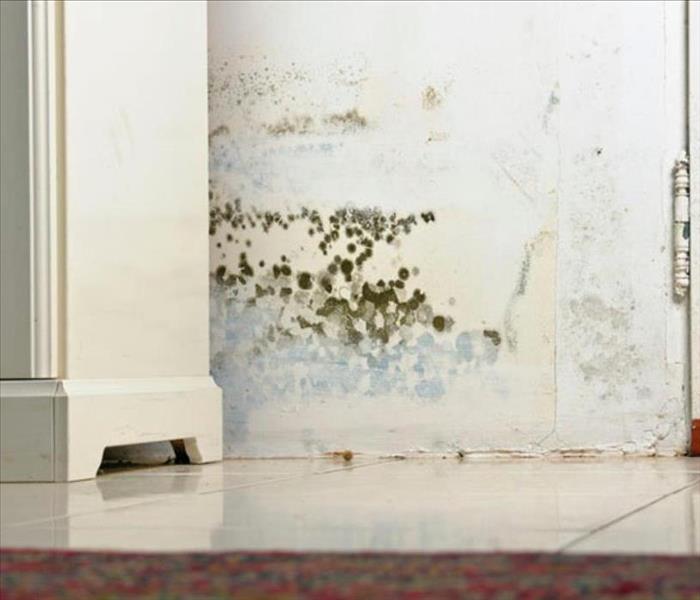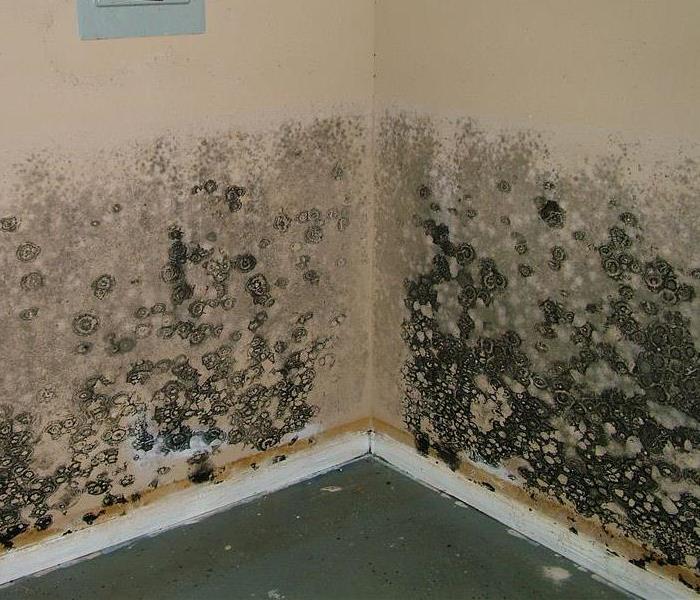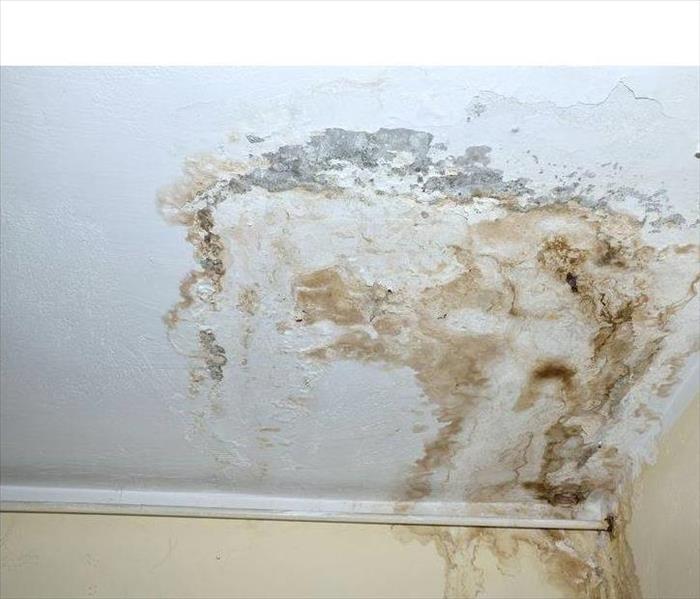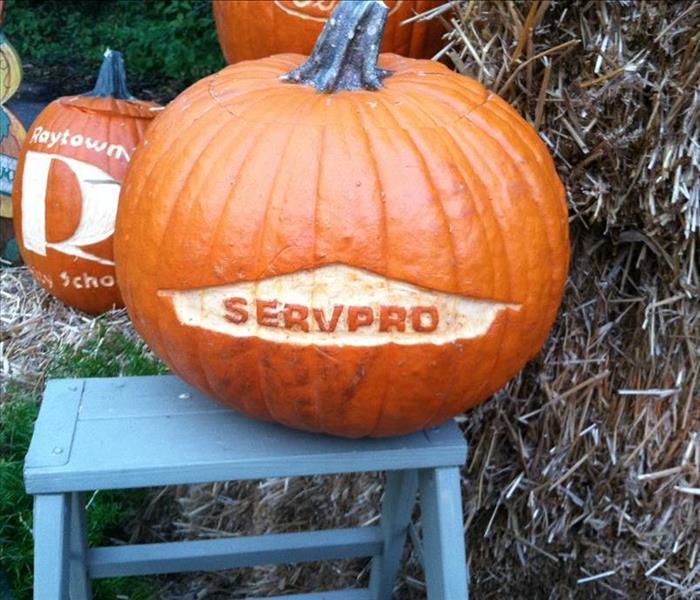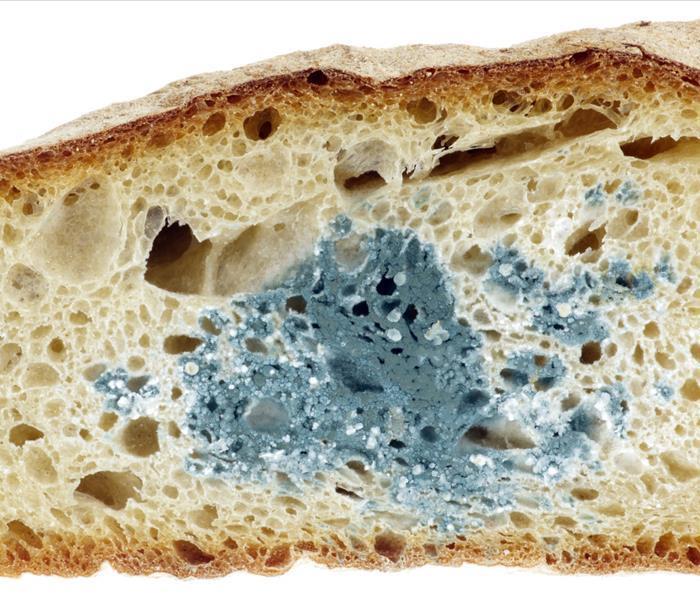Archived Mold Remediation Blog Posts
Does Your Crescenta Valley/E. Glendale Home Have A Mold Problem?
7/2/2024 (Permalink)
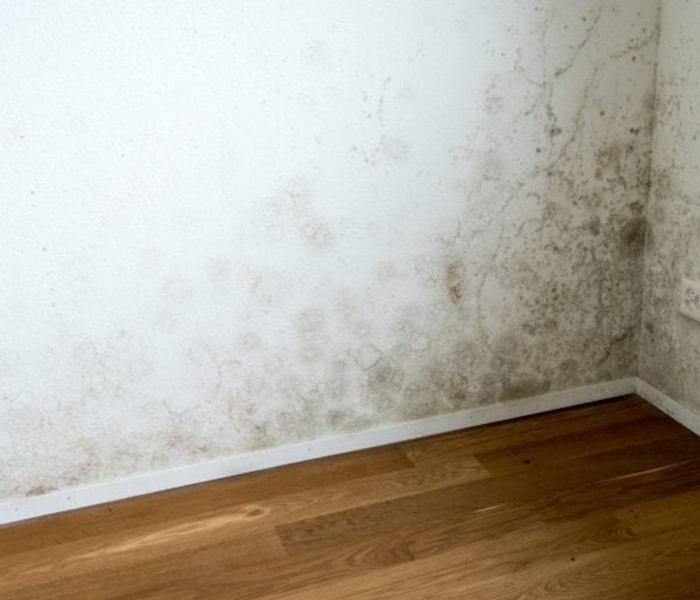 In LA County, mold can spread through a home in as little as 48 hours.
In LA County, mold can spread through a home in as little as 48 hours.
Microscopic mold spores naturally occur almost everywhere, both outdoors and indoors. This makes it impossible to remove all mold from a home or business. Therefore, mold remediation reduces the mold spore count back to its natural or baseline level. Some restoration businesses advertise “mold removal” and even guarantee to remove all mold, which is a fallacy. Consider the following mold facts:
- Mold is present almost everywhere, indoors and outdoors.
- Mold spores are microscopic and float along in the air and may enter your home through windows, doors, or AC/heating systems or even hitch a ride indoors on your clothing or a pet.
- Mold spores thrive on moisture. Mold spores can quickly grow into colonies when exposed to water. These colonies may produce health effects.
- Before mold remediation can begin, any sources of water or moisture must be addressed. Otherwise, the mold may return.
- Mold often produces a strong, musty odor and can lead you to possible mold problem areas.
- Even higher-than-normal indoor humidity can support mold growth. Keep indoor humidity below 45 percent.
If your home or business has a mold problem, we can inspect and assess your property and use our specialized training, equipment, and expertise to remediate your mold infestation.
If You See Signs of Mold, Call Us Today – (818) 842 - 1400
Presever your Jack-o'-Lantern
10/19/2018 (Permalink)
Halloween is right around the corner and for most of us that means we’re already starting to see decorations on every residential street, pumpkin-everything at Trader Joes and of course one of America’s favorite pastimes, the Jack O’ Lantern! It seems though that every time the perfectly-designed Jack O’ Lantern is set out on display for all to see, it too quickly loses its rich and robust appearance and in just a couple short days, mold creeps in making all that’s left into a dilapidated pile of mush.
As a professional mold remediation company, we’ve put a lot of thought into this topic and have come to the conclusion that as long as spores travel through the air and moisture settles in the pumpkin, the Jack O’ Lantern will always be an ideal source for mold to grow. Although there’s a short shelf live for your Jack O’ Lantern, we at SERVPRO of Crescenta Valley / East Glendale have thought of a couple ideas you can do to extend its lifespan.
Steps:
- After your pumpkin has been carved, rinse it out with water to get rid of excess strings and gunk.
- Using a large bucket or tub, fill it with 3 gallons of water or enough that will completely submerge the pumpkin.
- Stir three teaspoons of bleach into the water.
- Dunk the pumpkin underwater for a few minutes.
- Remove from bucket and place upside down for a couple hours until any pooled moisture evaporates. Using a hairdryer may speed up this step.
The bleach solution will slow down the mold growth and acts as an inhibitor however it will only be a matter of time before Thanksgiving arrives and let’s be honest….who wants to keep a Jack O’ Lantern for more than a couple weeks anyways?
We’ve also heard using the small silica packs (found in beef jerky bags, shoe boxes and electronic shipments) can help absorb excess moisture found in the environment and can help prolong the life of your sculpted pumpkin.
Happy Halloween everyone!!
Mold in Your Crescenta Valley / East Glendale Home
8/22/2018 (Permalink)
Microscopic mold spores naturally occur almost everywhere, both outdoors and indoors. This makes it impossible to remove all mold from a home or business. Therefore, mold remediation reduces the mold spore count back to its natural or baseline level. Some restoration businesses advertise “mold removal” and even guarantee to remove all mold, which is a fallacy. Consider the following mold facts:
· Mold is present almost everywhere, indoors and outdoors.
· Mold spores are microscopic and float along in the air and may enter your home through windows, doors, or AC/heating systems or even hitch a ride indoors on your clothing or a pet.
· Mold spores thrive on moisture. Mold spores can quickly grow into colonies when exposed to water. These colonies may produce allergens and irritants.
· Before mold remediation can begin, any sources of water or moisture must be addressed. Otherwise, the mold may return.
· Mold often produces a strong, musty odor and can lead you to possible mold problem areas.
· Even higher-than-normal indoor humidity can support mold growth. Keep indoor humidity below 45 percent.
If your home or business has a mold problem, we can inspect and assess your property and use our specialized training, equipment, and expertise to remediate your mold infestation.
If You See Signs of Mold, Call Us Today – (818) 842-1400
When You See Mold
8/21/2018 (Permalink)
If you see visible mold, do not disturb it. You can inadvertently spread the mold infestation throughout your home. When mold is disturbed, the mold can release microscopic mold spores which become airborne and can circulate inside your home.
What to Do:
· Stay out of affected areas.
· Turn off the HVAC system and fans.
· Contact SERVPRO of Crescenta Valley / East Glendale for mold remediation services.
What Not to Do:
· Don’t touch or disturb the mold.
· Don’t blow air across any surfaces with visible or suspected mold growth.
· Don’t attempt to dry the area yourself.
· Don’t spray bleach or other disinfectants on the mold.
About Our Mold Remediation Services
SERVPRO of Crescenta Valley / East Glendale specializes in mold cleanup and restoration; in fact, it’s a cornerstone of our business. Our crews are highly trained restoration professionals that use specialized equipment and techniques to properly remediate your mold problem quickly and safely.
If You See Signs of Mold, Call Us Today – (818) 842-1400
What to do when you see mold
8/9/2018 (Permalink)
If you see visible mold, do not disturb it. You can inadvertently spread the mold infestation throughout your home. When mold is disturbed, the mold can release microscopic mold spores which become airborne and can circulate inside your home.
What to Do:
· Stay out of affected areas.
· Turn off the HVAC system and fans.
· Contact SERVPRO of Crescenta Valley / East Glendale for mold remediation services.
What Not to Do:
· Don’t touch or disturb the mold.
· Don’t blow air across any surfaces with visible or suspected mold growth.
· Don’t attempt to dry the area yourself.
· Don’t spray bleach or other disinfectants on the mold.
About Our Mold Remediation Services
SERVPRO of Crescenta Valley / East Glendale specializes in mold cleanup and restoration; in fact, it’s a cornerstone of our business. Our crews are highly trained restoration professionals that use specialized equipment and techniques to properly remediate your mold problem quickly and safely.
How to Detect Mold in Your Home
7/31/2018 (Permalink)
There are many ways of initially detecting mold in your home. Here at SERVPRO of Crescenta Valley / East Glendale we have put together a few tips on how you can do so:
Smelling a Mold Odor
When you have mold growing hidden away in your house, often a moldy smell might be the only clue that it's there. Don't ignore mold odors if you can't see any mold. You should thoroughly inspect your home before any mold problems get worse.
Seeing Signs of Mold Growth
Visible mold growth might seem like an obvious sign of mold. However many people don't notice small amounts of mold growth or they think it's just soot or dirt. Sometimes people simply ignore visible mold in their house.
If you can see mold growth, even if it's only small, you should take action immediately. Small mold patches can spread and the fact that there is any mold shows that the conditions in your home are right for mold to grow.
If you don't take care of mold it will soon become a bigger problem. Visible mold growth could also be a sign that there is a much larger mold colony growing hidden away from view.
Sometimes you might not realize there is mold in your house, especially if it is unusual looking mold. Some mold growth looks white and thread-like. Other mold appears as clusters of small black spots. Mold can be black, gray-brown, gray-green or white in color. Mold growing behind wallpaper made of vinyl can even appear orange, pink or purple.
Signs of Water Problems
If you have had any long term moisture problems in your house it's usually inevitable they will lead to mold beginning to grow. So if you know you've had some water problems in your home then it's a pretty good sign you could have mold.
Some signs that you have a moisture problem include water stains or discoloration on walls, floors or ceilings in your house. Seeing these could be a clue that there is mold growing within or behind the material.
Another sign of a moisture problem is surface abnormalities like peeling, bubbling or cracking of the paint or wallpaper. If your walls are bowed, bulging or warped it probably means moisture has gotten into them. Another clue is if the surface of walls or other materials feel damp.
Water Leaks
The above signs of water problems in homes are usually created by leaks. However if you already know that you have had a water leak (such as leaking pipes or a leaking ceiling) then just that knowledge by itself, even if you don't see signs of water damage, is a good sign that you might have mold growing in your house around the area where the leak was.
Mold growth from leaks can often be hidden. If the leak was behind a wall or other surface then any mold will probably be hidden behind the surface too. Even if the leak was not behind a surface there could still be mold hidden out of view behind a wall or other surface from water which seeped through.
Past Flooding
If your house has been flooded in the past then it's likely that mold would've started to grow. Any mold would probably be growing in places where flood water remained the longest such as in the basement. Floods can often create mold growing out of view behind walls or under floors.
Condensation
If you see a lot of condensation in your home then it's a sign that you have a high amount of moisture and hence a sign that you could have a mold problem. Condensation will occur on surfaces such as glass windows or metal pipes. Mold could be growing where the condensation builds up and collects. Rusting indoor pipes are a sign that you could have a lot of condensation in your house.
Besides the fact that condensation creates a build up of moisture for mold to grow on, condensation can also be a sign that you have a humidity problem in your home. A high humidity level can feed mold and it is another sign that you might have a potential mold problem.
info by: http://moldpedia.com/mold-in-house-signs
Do You Know What Mold is?
7/13/2018 (Permalink)
Mold (or mould) is a term used to refer to fungi that grow in the form of multicellular thread-like structures called hyphae. Fungi that exist as single cells are called yeasts. Some molds and yeasts cause disease or food spoilage, others play an important role in biodegradation or in the production of various foods, beverages, antibiotics and enzymes.
Mold is also found in damp building materials where it often appears like stains and comes in a variety of colours. A must smell is an indication of microbial growth even when there is no visible growth. If mold is allowed to grow in homes or offices it can contribute to poor indoor air quality. Some molds such as the Dry Rot Fungus, Serpula lacrymans, are highly destructive. For more details about dry rot fungus read Occurrence and Significance of Dry Rot Fungus, Serpula lacrymans.
Mold growth requires moisture. The sources of moisture could be Washing, cooking, air humidifiers, condensation or leaks from plumbing or from the outside. Poor ventilation contributes to higher humidity levels and leads to condensation, which also allows mold growth.
Molds release small “spores” into the air. So, when mold grows indoors, the number of mold spores and fragments is usually higher indoors than it is outdoors. These spores are small enough that people can actually inhale them deep into the lungs.
Preventing Mold
5/31/2018 (Permalink)
Mold is a common household problem, developing in warm, damp environments. Mold can be colored green, purple, white, and orange. While mold plays an important role outside in the environment, breaking down dead plants, mold is unwelcome in homes.
Showers and bathrooms are a common location for mold to grow, but it is possible for mold to grow anywhere in a home. Mold can come inside a home from an outside growth through inadequately sealed windows or doors. Mold spores cannot be eliminated entirely, but they will not grow if the environment is dry and well ventilated. Mold growth can be prevented by ensuring if water damage occurs, clean up occurs quickly. Using air conditioners during humid seasons and exhaust fans in kitchen can help prevent mold from growing.
Other areas to monitor moisture to prevent mold growth: exterior walls and surfaces in need of insulation where condensation can build, air conditioner drip pans, check for leaks around refrigerator, ensure crawl spaces are well ventilated, and check for leaks around a tub.
These are a few simple tips for making sure mold is not growing in your home. If you do discover a mold growth, SERVPRO of Crescenta Valley / East Glendale provides mold remediation services for all types of residential and commercial properties.
Avoiding Mold in Your Bathroom
2/2/2018 (Permalink)
Mold grows where there is moisture. Unfortunately, the bathroom can be a very wet place making it hard to avoid moisture. Here are some easy tips on avoiding moisture and mold growth in your bathroom!
1. Buy a squeegee! After taking a bath or shower, clean off all the shower walls and glass of water. This will eliminate 3/4 of the moisture in the room.
2. Use a bathroom fan! Run it during your bath or shower and also for at least a half an hour after your shower. Another tip would be to put the fan on a timer!
3. Grout Sealer! Re-apply standard grout sealer every year to your bathroom tile to ensure that they remain waterproof!
SERVPRO of Crescenta Valley / East Glendale is faster to any size disaster
818-842-1400
Preserve your Jack O' Lantern from growing Mold
10/24/2017 (Permalink)
Halloween is right around the corner and for most of us that means we’re already starting to see decorations on every residential street, pumpkin-everything at Trader Joes and of course one of America’s favorite pastimes, the Jack O’ Lantern! It seems though that every time the perfectly-designed Jack O’ Lantern is set out on display for all to see, it too quickly loses its rich and robust appearance and in just a couple short days, mold creeps in making all that’s left into a dilapidated pile of mush.
As a professional mold remediation company, we’ve put a lot of thought into this topic and have come to the conclusion that as long as spores travel through the air and moisture settles in the pumpkin, the Jack O’ Lantern will always be an ideal source for mold to grow. Although there’s a short shelf live for your Jack O’ Lantern, we at SERVPRO of Crescenta Valley / East Glendale have thought of a couple ideas you can do to extend its lifespan.
Steps:
- After your pumpkin has been carved, rinse it out with water to get rid of excess strings and gunk.
- Using a large bucket or tub, fill it with 3 gallons of water or enough that will completely submerge the pumpkin.
- Stir three teaspoons of bleach into the water.
- Dunk the pumpkin underwater for a few minutes.
- Remove from bucket and place upside down for a couple hours until any pooled moisture evaporates. Using a hairdryer may speed up this step.
The bleach solution will slow down the mold growth and acts as an inhibitor however it will only be a matter of time before Thanksgiving arrives and let’s be honest….who wants to keep a Jack O’ Lantern for more than a couple weeks anyways?
We’ve also heard using the small silica packs (found in beef jerky bags, shoe boxes and electronic shipments) can help absorb excess moisture found in the environment and can help prolong the life of your sculpted pumpkin.
Happy Halloween everyone!!
If You See Mold
8/24/2017 (Permalink)
If you see visible mold, do not disturb it. You can inadvertently spread the mold infestation throughout your home. When mold is disturbed, the mold can release microscopic mold spores which become airborne and can circulate inside your home.
What to Do:
· Stay out of affected areas.
· Turn off the HVAC system and fans.
· Contact SERVPRO of Crescenta Valley / East Glendale for mold remediation services.
What Not to Do:
· Don’t touch or disturb the mold.
· Don’t blow air across any surfaces with visible or suspected mold growth.
· Don’t attempt to dry the area yourself.
· Don’t spray bleach or other disinfectants on the mold.
About Our Mold Remediation Services
SERVPRO of Crescenta Valley / East Glendale specializes in mold cleanup and restoration; in fact, it’s a cornerstone of our business. Our crews are highly trained restoration professionals that use specialized equipment and techniques to properly remediate your mold problem quickly and safely.
If You See Signs of Mold, Call Us Today – (818) 842-1400
Does your Crescenta Valley / East Glendale home have a mold problem?
8/14/2017 (Permalink)
Microscopic mold spores naturally occur almost everywhere, both outdoors and indoors. This makes it impossible to remove all mold from a home or business. Therefore, mold remediation reduces the mold spore count back to its natural or baseline level. Some restoration businesses advertise “mold removal” and even guarantee to remove all mold, which is a fallacy. Consider the following mold facts:
· Mold is present almost everywhere, indoors and outdoors.
· Mold spores are microscopic and float along in the air and may enter your home through windows, doors, or AC/heating systems or even hitch a ride indoors on your clothing or a pet.
· Mold spores thrive on moisture. Mold spores can quickly grow into colonies when exposed to water. These colonies may produce allergens and irritants.
· Before mold remediation can begin, any sources of water or moisture must be addressed. Otherwise, the mold may return.
· Mold often produces a strong, musty odor and can lead you to possible mold problem areas.
· Even higher-than-normal indoor humidity can support mold growth. Keep indoor humidity below 45 percent.
If your home or business has a mold problem, we can inspect and assess your property and use our specialized training, equipment, and expertise to remediate your mold infestation.
If You See Signs of Mold, Call Us Today – (818) 842-1400
Detecting Mold in Your Home
7/10/2017 (Permalink)
Smelling a Mold Odor
When you have mold growing hidden away in your house, often a moldy smell might be the only clue that it's there. Don't ignore mold odors if you can't see any mold. You should thoroughly inspect your home before any mold problems get worse.
Seeing Signs of Mold Growth
Visible mold growth might seem like an obvious sign of mold. However many people don't notice small amounts of mold growth or they think it's just soot or dirt. Sometimes people simply ignore visible mold in their house.
If you can see mold growth, even if it's only small, you should take action immediately. Small mold patches can spread and the fact that there is any mold shows that the conditions in your home are right for mold to grow.
If you don't take care of mold it will soon become a bigger problem. Visible mold growth could also be a sign that there is a much larger mold colony growing hidden away from view.
Sometimes you might not realize there is mold in your house, especially if it is unusual looking mold. Some mold growth looks white and thread-like. Other mold appears as clusters of small black spots. Mold can be black, gray-brown, gray-green or white in color. Mold growing behind wallpaper made of vinyl can even appear orange, pink or purple.
Signs of Water Problems
If you have had any long term moisture problems in your house it's usually inevitable they will lead to mold beginning to grow. So if you know you've had some water problems in your home then it's a pretty good sign you could have mold.
Some signs that you have a moisture problem include water stains or discoloration on walls, floors or ceilings in your house. Seeing these could be a clue that there is mold growing within or behind the material.
Another sign of a moisture problem is surface abnormalities like peeling, bubbling or cracking of the paint or wallpaper. If your walls are bowed, bulging or warped it probably means moisture has gotten into them. Another clue is if the surface of walls or other materials feel damp.
Water Leaks
The above signs of water problems in homes are usually created by leaks. However if you already know that you have had a water leak (such as leaking pipes or a leaking ceiling) then just that knowledge by itself, even if you don't see signs of water damage, is a good sign that you might have mold growing in your house around the area where the leak was.
Mold growth from leaks can often be hidden. If the leak was behind a wall or other surface then any mold will probably be hidden behind the surface too. Even if the leak was not behind a surface there could still be mold hidden out of view behind a wall or other surface from water which seeped through.
Past Flooding
If your house has been flooded in the past then it's likely that mold would've started to grow. Any mold would probably be growing in places where flood water remained the longest such as in the basement. Floods can often create mold growing out of view behind walls or under floors.
Condensation
If you see a lot of condensation in your home then it's a sign that you have a high amount of moisture and hence a sign that you could have a mold problem. Condensation will occur on surfaces such as glass windows or metal pipes. Mold could be growing where the condensation builds up and collects. Rusting indoor pipes are a sign that you could have a lot of condensation in your house.
Besides the fact that condensation creates a build up of moisture for mold to grow on, condensation can also be a sign that you have a humidity problem in your home. A high humidity level can feed mold and it is another sign that you might have a potential mold problem.
info by: http://moldpedia.com/mold-in-house-signs
What is Mold?
6/15/2017 (Permalink)
Mold (or mould) is a term used to refer to fungi that grow in the form of multicellular thread-like structures called hyphae. Fungi that exist as single cells are called yeasts. Some molds and yeasts cause disease or food spoilage, others play an important role in biodegradation or in the production of various foods, beverages, antibiotics and enzymes.
Mold is also found in damp building materials where it often appears like stains and comes in a variety of colours. A must smell is an indication of microbial growth even when there is no visible growth. If mold is allowed to grow in homes or offices it can contribute to poor indoor air quality. Some molds such as the Dry Rot Fungus, Serpula lacrymans, are highly destructive. For more details about dry rot fungus read Occurrence and Significance of Dry Rot Fungus, Serpula lacrymans.
Mold growth requires moisture. The sources of moisture could be Washing, cooking, air humidifiers, condensation or leaks from plumbing or from the outside. Poor ventilation contributes to higher humidity levels and leads to condensation, which also allows mold growth.
Molds release small “spores” into the air. So, when mold grows indoors, the number of mold spores and fragments is usually higher indoors than it is outdoors. These spores are small enough that people can actually inhale them deep into the lungs.
information provided by: http://www.moldbacteriafacts.com/what-is-mold/
Mold Prevention Tips
5/19/2017 (Permalink)
Mold is a common household problem, developing in warm, damp environments. Mold can be colored green, purple, white, and orange. While mold plays an important role outside in the environment, breaking down dead plants, mold is unwelcome in homes.
Showers and bathrooms are a common location for mold to grow, but it is possible for mold to grow anywhere in a home. Mold can come inside a home from an outside growth through inadequately sealed windows or doors. Mold spores cannot be eliminated entirely, but they will not grow if the environment is dry and well ventilated. Mold growth can be prevented by ensuring if water damage occurs, clean up occurs quickly. Using air conditioners during humid seasons and exhaust fans in kitchen can help prevent mold from growing.
Other areas to monitor moisture to prevent mold growth: exterior walls and surfaces in need of insulation where condensation can build, air conditioner drip pans, check for leaks around refrigerator, ensure crawl spaces are well ventilated, and check for leaks around a tub.
These are a few simple tips for making sure mold is not growing in your home. If you do discover a mold growth, SERVPRO of Crescenta Valley/ East Glendale provides mold remediation services for all types of residential and commercial properties.
What Causes Mold Growth?
2/20/2017 (Permalink)
What Causes Mold in Houses and Homes
What Mold Needs to Grow
Mold needs these conditions before it can begin to grow in a home:
- Mold spores
- A food source (eg wood, drywall, cotton)
- Darkness (mold can't grow under ultraviolet light)
- Warmth (mold can't grow in freezing temperatures)
- Oxygen
- Moisture (eg water leaks, humidity)
- Enough time (most molds can begin to grow in 24-48 hours if the conditions are right)
Moisture is really the key cause of mold growth since the other conditions on the list are always going to be present in homes.
So, essentially, the difference between whether mold grows in your home or not comes down to whether you have a moisture problem.
Humidity Causes Mold
If the weather's been very humid for a few days in a row you might notice mold starting to grow in your home. When it rains for several days it's especially common to see mold start to grow on walls, benches and other surfaces because of the wet air.
If you live where humidity in the air is naturally high, like by the coast or another large body of water, then mold growth in your home can also be a recurring problem.
Also when moisture inside your house evaporates into the air it increases the humidity indoors. If your home isn't well ventilated then the humidity will stay high for a long time.
Drying clothes indoors on clothes lines or stands is a common culprit when it comes to causes of indoor humidity problems. The household HVAC system can also create humidity troubles while it artificially heats or cools the air.
Sometimes people use humidifiers in their homes. But there are molds that only need the humidity level to be higher than 55% to start growing. So if you need to use a humidifier in your home make sure to keep the humidity below 55%.
Not only does high humidity feed mold, but it means that puddles of water and damp materials in the home take longer to dry out. These wet surfaces can in turn create mold growth of their own.
Leaking Pipes Cause Mold
Water leaks from pipes are a common cause of mold growth. The worst leaks are the ones that go undetected because they are hidden out of view, like inside a wall. By the time you discover these leaks mold has usually started to grow already.
Leaks in Roof Cause Mold
Like some leaking pipes, a roof that leaks into the attic might not be discovered until it's already lead to mold growth.
The best thing to do is to check the attic regularly for leaks and keep an eye on the ceiling below the attic. If you notice any signs of water damage on the ceiling or any mold that has grown through then you probably have a leaking roof.
Condensation Causes Mold
Cold surfaces can create condensation in your home. Condensation collects on cold metal pipes as well as on cold concrete floors, even if there is carpet over the top, and on walls. Places like these where condensation occurs are prime spots for mold growth.
Poor Ventilation Causes Mold
If your home is poorly ventilated it can create pockets of stagnant moist air which mold thrives in. Steam and water evaporating into the air creates humidity inside which then needs to be circulated outdoors through windows to keep the moisture level balanced.
Poor ventilation also means wet surfaces dry out more slowly. Ventilation is especially important in rooms such as the bathroom and the kitchen where there is a lot of steam.
Wet Clothes Cause Mold
If you leave clothes wet for a long period of time in your house mold can grow on them as well as on other surfaces due to the moisture wet clothes release into your home.
Damp clothes left in a pile waiting to be washed for more than a day can lead to mold growth. Clothes left wet for over a day after being washed may also end up fostering mold.
Drying your clothes in a dryer instead of outside on the line releases a large amount of moisture into your home if the drier is not vented outside the house. Clothes drying inside on indoor clothes lines or racks will also create a build up of moisture inside unless the room is well ventilated.
Flooding Causes Mold
It is almost inevitable that some mold problems will develop after your home has been affected by flooding. Obviously your house will be very wet for a long time during a flood, taking days or even weeks to dry out. Since mold only needs a suitable surface to be wet for 24 hours before it can grow this means there is a huge risk of mold growth.
Some dangerous toxic molds require more extreme conditions than common molds do, such as the toxic mold Stachybotrys chartarum which requires material to be very wet for several days to grow. A flood can create these conditions putting your home more at risk of being infested with dangerous toxic molds.
Damp Basement Causes Mold
Basements often contain higher amounts of moisture or humidity than other rooms because they are usually not well ventilated. Basements are also often colder meaning more condensation occurs which leads to dampness and humidity.
Also any water from leaks in your home will often end up running down to the basement since it is lower than all the other rooms. Not only is mold more likely to grow in basements but because they are usually neglected mold growth may not be discovered until it is well set in.
Water at the House's Foundation Causes Mold
Water building up in the yard and ground around the base of your house can cause frequent water problems for the foundation of your home.
If the ground around your home slopes towards the house rainwater will end up building up at the foundation. If this causes constant problems you might even need to do some landscaping to modify the slope of the ground so water drains away from the house. Alternatively ditches and drains can be dug to channel water away from the home.
info by: http://blackmold.awardspace.com/mold-causes.html
Understanding Mold
2/6/2017 (Permalink)
 The Key to Mold Control is Moisture Control!
The Key to Mold Control is Moisture Control!
“I think I have toxic black mold at my property!”
If we had a nickel for every time we heard someone say this…
Mold is a situation that’s never pleasant to come across at a property. We’ve learned in over the past 3 decades of being in business, the conversation that surrounds mold can sometimes be confusing, full of headaches and unnecessary concerns. Although it’s still a topic of heated debate in some circles, we have boiled down some basic guidelines to understanding what mold is should SERVPRO of Crescenta Valley / East Glendale help you with a future mold issue, below is what you can expect:
- Mold can be found almost anywhere; it can grow on virtually any organic material, as long as moisture and oxygen are present.
- There are molds that can grow on wood, paper, carpet, foods, and insulation. Molds reproduce by making spores that cannot be seen without magnification. Mold spores waft through the indoor and outdoor air continually.
- When mold spores land on a damp spot indoors, they may begin growing and digesting whatever they are growing on in order to survive. Molds gradually destroy the things they grow on. Bacteria can start to grow within hours and mold can start to grow within days. Mold spores can lay dormant for years until an ideal growing condition develops, in which they start to flourish. Especially during the summer, the warm humid conditions are a perfect microenvironment for mold growth.
- When excessive moisture accumulates in buildings or on building materials, mold growth will often occur—particularly if the moisture problem remains undiscovered or unaddressed.
- Before the growth of mold becomes visible, there may be a faint musty or earthy smell. In time, mold will appear on the outside of the wall as a stain or discoloration. In a standard situation, SERVPRO of Crescenta Valley / East Glendale examines the structure for any visible signs of mold and removes the mold growth and excess spores, returning the area back to normal levels.
- All molds have the potential to cause health effects.
- Potential health concerns is an important reason to prevent mold growth to form an address any existing mold growth indoors.
- It is impossible to eliminate all molds and mold spores in an indoor environment, with the exception being in a proper containment after a mold remediation job is complete by a SERVPRO of Crescenta Valley / East Glendale professional. To confirm mold is no longer present, an Industrial Hygienist (CIH) will take a spore count to confirm mold is no longer present.
- The purpose of mold remediation is to remove the mold to prevent human exposure and damage to building materials and furnishings. It is necessary to clean up mold contamination, not just kill it.
- Mold growth can be controlled indoors by controlling the moisture.
- Some situations require the assistance of an Indoor Air Quality/Environmental Professional (IEP) with specialized equipment and services needed to assess and/or repair the structure. IEPs can test and clear a structure for mold by collecting air and surface samples. Then they can determine whether the mold has been successfully decontaminated.
- Mold growth can be controlled indoors by controlling the moisture.
If you suspect mold at your property, feel free to call SERVPRO of Crescenta Valley / East Glendale at (818) 790-2021 and get connected to one of our highly trained mold remediation technicians.
Preserving your Jack O' Lantern from growing mold
10/20/2016 (Permalink)
Halloween is right around the corner and for most of us that means we’re already starting to see decorations on every residential street, pumpkin-everything at Trader Joes and of course one of America’s favorite pastimes, the Jack O’ Lantern! It seems though that every time the perfectly-designed Jack O’ Lantern is set out on display for all to see, it too quickly loses its rich and robust appearance and in just a couple short days, mold creeps in making all that’s left into a dilapidated pile of mush.
As a professional mold remediation company, we’ve put a lot of thought into this topic and have come to the conclusion that as long as spores travel through the air and moisture settles in the pumpkin, the Jack O’ Lantern will always be an ideal source for mold to grow. Although there’s a short shelf live for your Jack O’ Lantern, we at SERVPRO of Crescenta Valley / East Glendale have thought of a couple ideas you can do to extend its lifespan.
Steps:
- After your pumpkin has been carved, rinse it out with water to get rid of excess strings and gunk.
- Using a large bucket or tub, fill it with 3 gallons of water or enough that will completely submerge the pumpkin.
- Stir three teaspoons of bleach into the water.
- Dunk the pumpkin underwater for a few minutes.
- Remove from bucket and place upside down for a couple hours until any pooled moisture evaporates. Using a hairdryer may speed up this step.
The bleach solution will slow down the mold growth and acts as an inhibitor however it will only be a matter of time before Thanksgiving arrives and let’s be honest….who wants to keep a Jack O’ Lantern for more than a couple weeks anyways?
We’ve also heard using the small silica packs (found in beef jerky bags, shoe boxes and electronic shipments) can help absorb excess moisture found in the environment and can help prolong the life of your sculpted pumpkin. We’d love to hear if you have any ideas that may help save the life of your Jack O’ Lantern. You can either send us a message at SERVPRO2720@SERVPROburbank.com or through any our social media channels –
https://www.facebook.com/SERVPROcrescentavalleyeastglendale/?hc_ref=PAGES_TIMELINE&fref=nf
https://twitter.com/SERVPROBurbank
Happy Halloween everyone!!
Keeping mold from growing on your food
8/24/2016 (Permalink)
Buying small amounts and using food quickly is probably the best way to prevent mold growth in food. However, there are other practices that you can implement to prevent mold growth in food.
- Examine food well before you buy it. Check food in glass jars, look at the stem areas on fresh produce, and avoid bruised produce. Fresh meat and poultry are usually mold free, but cured and cooked eats might not be. Examine them carefully. The exception is that some salamis -- San Francisco, Italian, and Eastern European types -- have a characteristic thin, white mold coating that is safe to consume; however, they should not show any other mold. Dry-cured country hams normally have surface mold that must be scrubbed off before cooking.
- When serving food, keep it covered to prevent exposure to mold spores in the air. Use plastic wrap to cover foods you want to stay moist -- fresh or cut fruits and vegetables and green and mixed salads.
- Empty opened cans of perishable foods into clean storage containers and refrigerate them promptly. Make sure that the storage container is tightly covered.
- Use leftovers within 3 to 4 days so mold does not have a chance to grow.
Cleanliness is the key to controlling mold. Mold spores from contaminated food can build up in your refrigerator, dishcloths, and other cleaning utensils. To eliminate mold:
- Clean the inside of the refrigerator every few months with one tablespoon of baking soda dissolved in a quart of water. Rinse with clear water and dry. Scrub visible mold (usually black) on rubber casings using three teaspoons of bleach in a quart of water.
- Keep dishclothes towels, sponges, and mops clean and fresh. A musty smell means they are spreading mold around. Discard items you cannot clean or launder.
- Keep the humidity level in the house below 40%.
SOURCE:
U.S. Department of Agriculture. 2002. Molds on Food: Are They Dangerous. The complete publication is available on-line at:http://www.fsis.usda.gov/Fact_Sheets/Molds_On_Food/index.asp
Tips to keep Mold at bay in the bathroom
8/23/2016 (Permalink)
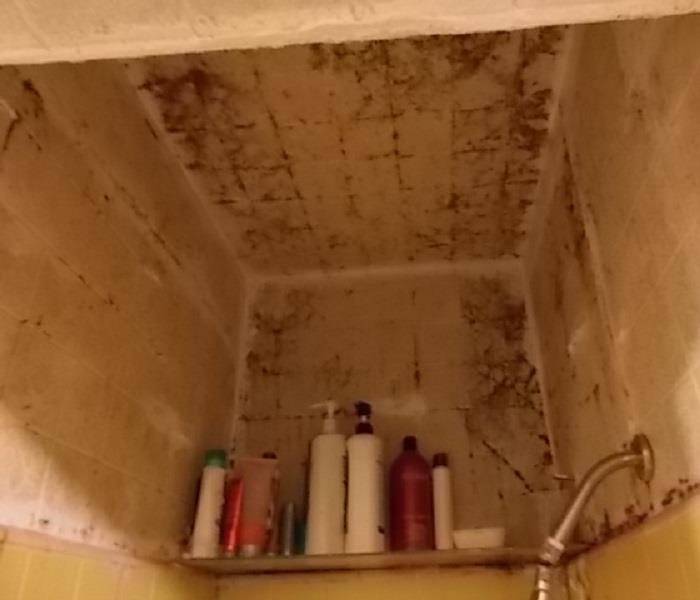 The Key to Mold Control is Moisture Control!
The Key to Mold Control is Moisture Control!
Let’s face it, when it comes to parts of our homes we wish we didn’t have to think much about, the bathroom would probably top that list. For most of us, the bathroom is the one part of the house that we want to get away from, just as quickly as we entered. And as a cleaning and restoration company who often finds ourselves entering into some pretty serious bathroom maintenance concerns, we’ve found that mold damage is one of the worst issues to face. That’s why we wanted to share some worthwhile information with you (the reader!) so that the next time you’re cleaning your home or doing various housekeeping chores, you can have some helpful pointers in mind for keeping mold growth at bay in your bathroom.
“Bathrooms are common places to find mold because heat and moisture accumulate on a regular basis, and this happens to be the perfect environment that mold needs to grow.” Some common reasons why mold growth is found especially in the bathroom are due to:
- Lack of air circulation and ventilation that traps moisture after bathing
- Leaky toilets, sinks or pipes
- Improper installation of bathtub pan or shower building materials
- Other damp organic materials such as rugs, paper products, wood, wallpaper, drywall, etc…
There are several different methods you can follow to prevent mold growth.
- Make sure you have a bathroom fan that works and is the right size in relation to the size of your bathroom
- If you don’t have a bathroom fan or window, take some time to dry the wet surfaces (walls, mirror, and ceiling) with a towel after your shower. Squeegee your shower walls to get rid of extra moisture.
- Seal the grout in your tile annually to ensure its water proof. Repair or replace damaged grout and caulk.
- Leave bathroom windows and doors open after your shower to let all the steam out. We recommend doing this for at least a half hour after bathing.
- Clean the bathroom with eco-friendly mold-preventing cleaners like Concrobium or Sporicidin. Also, general household cleaning solutions with bleach can be a great way to lessen the likelihood for mold to growth on dust, dirt and buildup on surfaces.
- If you’re going out of town, don’t just turn your thermostat off. Keep it at 74 or below to prevent a mold fest.
- Check your sinks for leaks.
- Spread the shower curtain back out after your shower to prevent mold from growing in the folds.
- Clean the bathroom regularly, at least once a week. Don’t forget easy-to-miss places like the shower walls. Wash your cloth shower curtain and rug too!
- Call SERVPRO of Crescenta Valley / East Glendale for additional tips and tricks for what to do (and NOT DO) if you have found mold growing in your bathroom.
(Shout out to http://howtobuildit.org/2013/08/13/how-to-avoid-bathroom-mold/ for helping contribute to some of these great ideas.)
Crescenta Valley Residents: Follow These Mold Safety Tips If You Suspect Mold
7/14/2016 (Permalink)
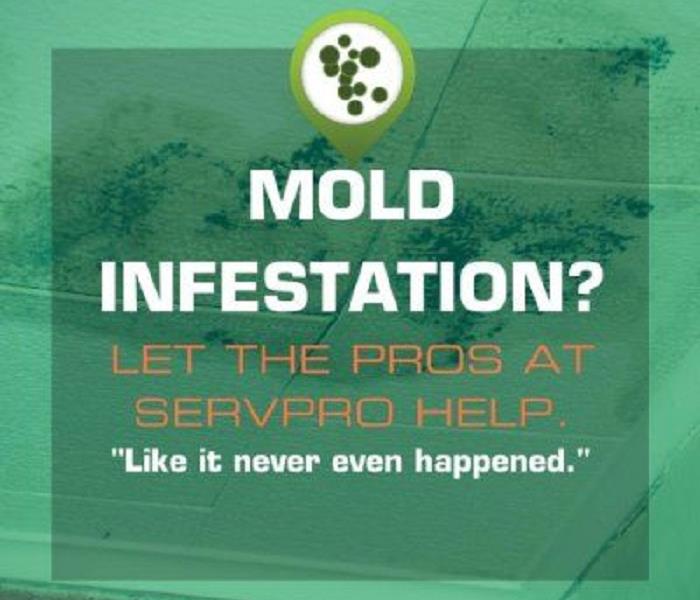 Be careful! Without proper training, you could be spreading mold throughout your home.
Be careful! Without proper training, you could be spreading mold throughout your home.
If you see visible mold, do not disturb it. You can inadvertently spread the mold infestation throughout your home. When mold is disturbed, the mold can release microscopic mold spores which become airborne and can circulate inside your home.
What to Do:
· Stay out of affected areas.
· Turn off the HVAC system and fans.
· Contact SERVPRO of Crescenta Valley / East Glendale for mold remediation services.
What Not to Do:
· Don’t touch or disturb the mold.
· Don’t blow air across any surfaces with visible or suspected mold growth.
· Don’t attempt to dry the area yourself.
· Don’t spray bleach or other disinfectants on the mold.
About Our Mold Remediation Services
SERVPRO of Crescenta Valley / East Glendale specializes in mold cleanup and restoration; in fact, it’s a cornerstone of our business. Our crews are highly trained restoration professionals that use specialized equipment and techniques to properly remediate your mold problem quickly and safely.
If You See Signs of Mold, Call Us Today – (818) 790-2021
Does Your Crescenta Valley or East Glendale Home Have A Mold Problem?
6/23/2016 (Permalink)
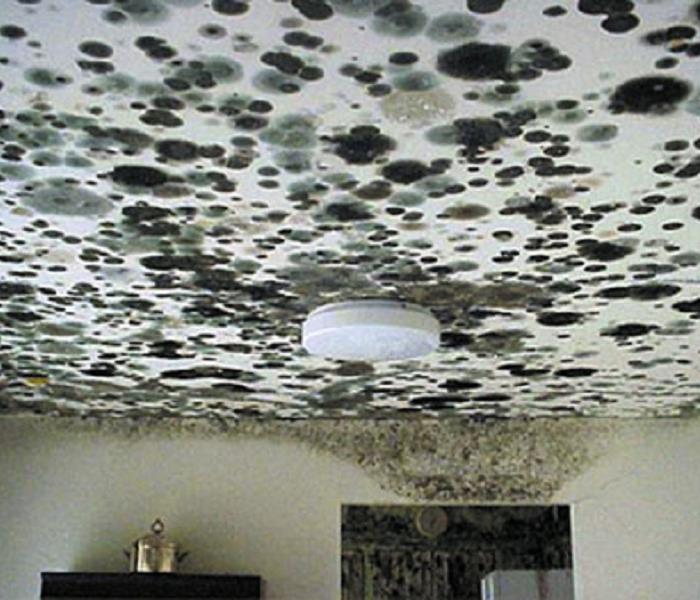 In Crescenta Valley or East Glendale, mold can spread through a home in as little as 48 hours.
In Crescenta Valley or East Glendale, mold can spread through a home in as little as 48 hours.
Microscopic mold spores naturally occur almost everywhere, both outdoors and indoors. This makes it impossible to remove all mold from a home or business. Therefore, mold remediation reduces the mold spore count back to its natural or baseline level. Some restoration businesses advertise “mold removal” and even guarantee to remove all mold, which is a fallacy. Consider the following mold facts:
· Mold is present almost everywhere, indoors and outdoors.
· Mold spores are microscopic and float along in the air and may enter your home through windows, doors, or AC/heating systems or even hitch a ride indoors on your clothing or a pet.
· Mold spores thrive on moisture. Mold spores can quickly grow into colonies when exposed to water. These colonies may produce allergens and irritants.
· Before mold remediation can begin, any sources of water or moisture must be addressed. Otherwise, the mold may return.
· Mold often produces a strong, musty odor and can lead you to possible mold problem areas.
· Even higher-than-normal indoor humidity can support mold growth. Keep indoor humidity below 45 percent.
If your home or business has a mold problem, we can inspect and assess your property and use our specialized training, equipment, and expertise to remediate your mold infestation.
If You See Signs of Mold, Call Us Today – (818) 790-2021





 24/7 Emergency Service
24/7 Emergency Service

